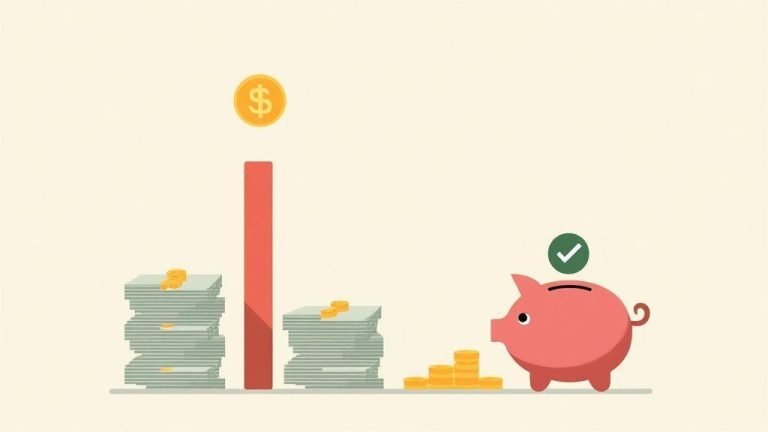3. 10 common financial emergencies in the US and how to prepare. This guide helps you build an emergency savings fund and plan emergency credit for loan gaps. Start with small weekly steps. Keep a simple budget so your savings grow. Protect your income with job-loss planning and short-term disability insurance. Prepare for medical bills, manage debt after a job loss, and find quick loan options without high interest. Get practical tips to fund home repairs, plan car fixes, and ready your family for natural disasters. Clear, easy steps you can use now.
Build an emergency savings fund and plan emergency credit access for loan gaps
Start by treating your emergency fund like a non-negotiable bill: move a small amount aside the day you get paid. Automatic transfers make this a habit fast. That money is your first line of defense when loans don’t cover a gap or a bill pops up — think of it as a fire extinguisher you hope you never need.
You also need a backup plan for credit. A pre-approved low-interest line or a credit card you rarely use gives breathing room if a loan is delayed. Check rates, fees, and repayment terms now, not when you’re stressed — and review site terms and conditions and lender disclosures ahead of time.
Decide ahead of time when to tap savings and when to use credit. Use savings first for small repairs or short gaps; use credit only for bigger, urgent costs and only if you have a plan to pay it down. Review this plan annually and after big life changes.
How you can start an emergency savings fund with small weekly steps
Begin with tiny wins: move $5–$10 each week into a separate account. Skip one coffee or takeout meal and send that cash to savings. Use an app or set up an automatic weekly transfer so you forget about it and watch it grow.
Set short milestones to stay motivated: aim for $500, then $1,000, then a month’s worth of bills. Use bonuses, tax refunds, or gifts to speed progress.
Use emergency credit access wisely so you avoid high-interest surprises
Not all credit is the same. A low-interest personal line or a card with a sensible APR is fine as backup. Avoid payday loans or cards with huge fees. Read interest rates, fees, and due dates before borrowing. Have rules for when to use credit, set a repayment timeline, and call lenders if you fall behind — many offer hardship plans.
Protect your income with job-loss financial planning and short-term disability insurance
When a paycheck stops, you feel it immediately. Build a safety net: an emergency fund covering several months of living costs, a list of quick income sources, and a review of existing benefits. For background on our approach and resource lists, see our about page.
Short-term disability insurance can keep cash flowing when illness or injury prevents work. Read policies for waiting periods, payout length, and covered events so you won’t be surprised when you need it.
Combine insurance with practical steps: cut nonessential spending, pause subscriptions, and contact your mortgage servicer or landlord early about relief. Practice the plan once a year so you know where documents live, who to call, and how fast you can tap savings or backup credit.
How you prepare for unexpected medical bills with insurance and savings
Know what your health plan covers and where gaps exist. Call your insurer, ask about in-network providers, and get cost estimates for likely tests or procedures. If a big out-of-pocket cost appears, ask providers for payment plans or sliding-scale options.
Keep a small medical emergency fund separate from general savings — even a few hundred dollars can stop debt from snowballing. Use HSAs or FSAs if available. If a bill arrives, call to negotiate: many providers will offer discounts or low-cost plans.
Keep your finances stable with basic debt management strategies after job loss
List creditors, interest rates, and minimum payments. Prioritize secured debts (mortgage, car) to avoid losing core assets. Call creditors to explain your job loss — they often offer hardship plans or short-term relief.
Trim spending quickly: pause services you don’t need, lower utilities, and delay nonurgent purchases. For credit card debt, consider a low-rate balance transfer or a short-term personal loan to reduce interest. Small moves now prevent big headaches later.
Choose short-term disability insurance and know quick loan options
Pick a short-term disability plan with clear coverage start dates and benefit amounts, and keep proof of employment and medical records handy. If you need cash fast, compare employer advances, credit unions, or small personal loans — these usually beat payday lenders. Borrow only what you must and plan repayment.
Prepare your home, car, and family for natural disasters with targeted funds
Match your money plan to real risks: keep separate target funds for home, car, and family emergencies so you don’t raid the wrong jar. Use small, regular transfers so each fund grows without pain.
Mix savings with low-cost loan options for larger needs. A preapproved personal loan or a home equity line can help with major repairs — check rates ahead of time. Think of loans as backup fuel: use them smartly and only when necessary. For practical planning tips, review our resource pages and consider contacting us directly via the contact form.
Keep your family in the loop and set simple roles: who handles car repairs, who calls the contractor, and who keeps receipts and photos. Follow a short post-disaster checklist: document damage, call your insurer, get one written repair quote before spending, and use your fund or a low-rate loan if the payout will take weeks.
Build a home repair emergency fund and a simple repair checklist
Set a dollar goal based on your home age and local hazards — aim for at least one month of mortgage or rent plus $1,000–$5,000 for repairs. Automate transfers each payday into a separate high-yield savings account.
Create a concise repair checklist: take photos, shut off utilities if needed, make temporary fixes, get one written estimate from a licensed pro (a second quote for big jobs), keep receipts, file an insurance claim promptly, and use your repair fund or a low-rate loan if necessary.
Set up car repair emergency planning and affordable loan choices for fixes
Know typical costs for your car model and local labor. Set aside a small monthly amount for brakes, tires, and unexpected repairs. Join roadside assistance or keep contacts for a trusted local mechanic. Keep service records and photos to speed claims or warranty work.
If repairs exceed savings, choose loan options with reasonable rates: credit union personal loans, short-term installment loans from reputable lenders, or a 0% intro APR card if you can pay within the promo window. Avoid payday loans and high-rate offers.
Natural disaster preparedness steps and emergency credit access
Keep an emergency kit, copies of important papers, photos of your home and car, and proof of ownership. Contact your insurer quickly and document each call. Know your preapproved personal loan amounts, credit card limits, and whether a home equity line is available. Check disaster aid options like FEMA grants and local nonprofit help. Store lender phone numbers, cards, and IDs in a waterproof bag and review our privacy practices for protecting sensitive documents.
Why use the “3 10 common financial emergencies in the US and how to prepare” approach?
The phrase “3 10 common financial emergencies in the US and how to prepare” highlights a simple checklist-style approach: identify a small number of high-impact shocks, set three practical responses for each, and focus on ten common emergencies (job loss, medical bills, car repairs, home damage, natural disasters, etc.). This structure keeps planning actionable and easy to remember, so you can build funds, arrange backup credit, and practice responses before a crisis.
Conclusion
You’ve got a clear map: build a small, automatic emergency fund, plan low-cost emergency credit, and keep a simple budget so your savings grow. Use short weekly steps and celebrate tiny wins so the habit sticks.
Protect your income with job-loss planning and the right short-term disability coverage. Know your medical coverage, keep a separate medical stash, and negotiate bills. For home and car problems, treat each as its own repair jar and get two quotes before spending. When you borrow, avoid payday traps and choose the lowest-cost option available.
Frequently asked questions
- What is the first step to handle a sudden job loss?
Start an emergency fund. Aim for 3 months, then build toward 6 months of bills.
- How do you pay for unexpected medical bills fast?
Use savings first. Call the hospital and ask for a payment plan or discount.
- How can “3 10 common financial emergencies in the US and how to prepare” guide my plan?
It lists real risks and quick fixes. Use it to set priorities, make a budget, and build your emergency stash.
- What should you do for urgent home or car repairs?
Keep a small repair fund. Get two quotes and pick the most cost-effective qualified option. - How do you stay ready for natural disasters or big losses?
Keep cash, copies of important papers, and adequate insurance. Review and practice your plan twice a year.



